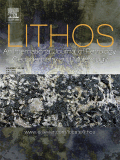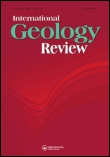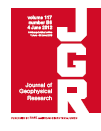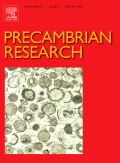
LITHOS
Scope & Guideline
Pioneering Discoveries in Geochemistry and Petrology.
Introduction
Aims and Scopes
- Petrogenesis of Igneous Rocks:
The journal frequently publishes studies on the formation processes and evolution of various igneous rock types, including granites, basalts, and other volcanic rocks, providing insights into their source, composition, and tectonic settings. - Geochemistry and Isotopic Studies:
A significant focus is placed on the geochemical analysis and isotopic characterization of rocks, which aids in understanding mantle processes, crustal evolution, and the impact of subduction and collision events on magmatic systems. - Tectonic Implications:
Many papers explore the tectonic implications of magmatic and metamorphic processes, linking geological phenomena to larger tectonic frameworks, such as continental collision, subduction zones, and the evolution of orogenic belts. - Metamorphic Processes:
Research on metamorphic rocks, particularly high-pressure and high-temperature conditions, is also a core area, examining the transformation of rocks under different geological settings and their implications for crustal dynamics. - Field Studies and Experimental Petrology:
Field-based studies and experimental petrology are key methodologies in the journal, providing empirical data and experimental results that contribute to the understanding of rock formation and alteration processes.
Trending and Emerging
- Interdisciplinary Approaches:
There is an increasing trend towards interdisciplinary research that combines geology with other fields such as geochemistry, geophysics, and environmental sciences, fostering a more holistic understanding of geological processes. - Focus on Rare Earth Elements (REEs):
Studies related to the petrogenesis and mineralization of rare earth elements have gained prominence, reflecting the growing importance of REEs in technology and industry. - High-Pressure Metamorphism:
Research on high-pressure and ultrahigh-pressure metamorphic processes has become more frequent, highlighting the significance of subduction zones and the dynamics of deep crustal processes. - Technological Advances in Geochronology:
The application of advanced geochronological techniques, such as in situ U-Pb zircon dating and Lu-Hf isotopes, is becoming increasingly common, allowing for more precise age determinations and insights into magmatic evolution. - Climate-Influenced Geological Processes:
Emerging studies are beginning to explore the interactions between geological processes and climate change, particularly in the context of how magmatism and tectonics influence and respond to climatic factors.
Declining or Waning
- Sedimentary Petrology:
There appears to be a waning interest in the detailed study of sedimentary petrology, with fewer papers exploring sedimentary processes, depositional environments, and the petrology of sedimentary rocks compared to igneous and metamorphic studies. - Regional Geology Studies:
Research focusing exclusively on regional geology without a strong emphasis on petrogenetic or geochemical analysis seems to be declining. The trend indicates a shift towards more integrated studies that combine multiple aspects of geology. - Paleontological Aspects in Petrology:
There is a noticeable decrease in the inclusion of paleontological perspectives within petrological studies, suggesting a potential narrowing of focus towards strictly geological and geochemical processes. - Lesser Focus on Volcanic Hazards:
The journal has published fewer studies directly addressing volcanic hazards and their societal implications, which may indicate a reduced emphasis on applied geology in favor of fundamental research.
Similar Journals

MINERALOGY AND PETROLOGY
Pioneering Research in Earth SciencesMINERALOGY AND PETROLOGY, published by Springer Wien, is a premier academic journal that has been contributing to the fields of geochemistry, petrology, and geophysics since its inception in 1987. With an ISSN of 0930-0708 and an E-ISSN of 1438-1168, this journal is recognized for its rigorous peer-reviewed articles that advance the understanding of mineral and rock formation processes, their physical and chemical properties, and the implications for broader Earth sciences. Holding a respectable impact factor and categorized in the Q2 quartile for both Geochemistry and Petrology, as well as Geophysics, MINERALOGY AND PETROLOGY ranks favorably among its peers, placing it within the top 50% of scholarly publications in these fields. Researchers, professionals, and students alike will find a wealth of knowledge in its pages, as it serves as a valuable resource for those aiming to explore the complexities of Earth's materials and compositions. Although it does not offer an Open Access option, the journal assures high-quality, impactful research that is crucial for ongoing advancements in Earth sciences.

GEOTECTONICS
Charting New Territories in Tectonic Research.GEOTECTONICS is a distinguished academic journal published by PLEIADES PUBLISHING INC, focusing on key developments in the field of geology. Established in 1978, the journal has dedicated itself to exploring the intricate processes and phenomena associated with Earth's tectonic systems, making substantial contributions to Earth and Planetary Sciences. With an impressive impact factor reflected in its Q2 ranking within the Scopus category of Geology, GEOTECTONICS stands out as a valuable resource for researchers, professionals, and students alike. The journal offers a platform for rigorous peer-reviewed research that spans both fundamental theories and practical applications in geosciences, affirming its significance in fostering academic discourse and advancing geological knowledge. Although it currently does not offer open access, the journal's accessible format and continued publication through to 2024 ensures that it remains at the forefront of geoscientific inquiry.

GEOCHEMICAL JOURNAL
Illuminating the Path of Geochemical Research Since 1966GEOCHEMICAL JOURNAL, published by the Geochemical Society of Japan, stands as a pivotal platform for researchers and professionals dedicated to the fields of geochemistry and petrology, as well as geophysics. With the ISSN 0016-7002 and E-ISSN 1880-5973, this journal has been disseminating cutting-edge research since its inception in 1966 and continues to provide invaluable insights into the complexities of Earth's processes. Currently categorized in the Q3 quartile for both Geochemistry and Petrology and Geophysics, the journal ranks in the 40th and 36th percentiles, respectively, as per Scopus metrics, reflecting its growing influence and relevance in the scientific community. The journal accepts a range of scholarly articles, aiming to foster a deeper understanding of geochemical phenomena while promoting interdisciplinary collaboration among academicians and practitioners. Although not open access, the GEOCHEMICAL JOURNAL's commitment to quality research and education underscores its vital role in advancing the discourse within geoscience.

INTERNATIONAL GEOLOGY REVIEW
Unveiling the secrets of our planet, one article at a time.INTERNATIONAL GEOLOGY REVIEW, published by Taylor & Francis Inc, is a premier journal dedicated to advancing the field of geology since its inception in 1959. With its Q1 ranking in the field of Geology for 2023, this journal is a significant platform for researchers, professionals, and students exploring the intricacies of Earth and planetary sciences. The journal has been rated in the 81st percentile within Scopus rankings, reflecting its influence and the high quality of articles published. Although it does not offer Open Access options, the journal maintains a rigorous peer-review process to ensure the publication of original and impactful research. With an extensive archive projected to continue until 2024, INTERNATIONAL GEOLOGY REVIEW serves as an essential resource for those seeking to deepen their understanding of geological phenomena, making it a vital contributor to the global scientific community.

Solid Earth Sciences
Innovating research for a sustainable Earth.Solid Earth Sciences is a dynamic open-access journal published by Elsevier, dedicated to advancing our understanding of the Earth's subsurface processes and materials. Since its inception in 2016, the journal has established itself as a vital resource for researchers and professionals in the fields of geochemistry, petrology, geology, geophysics, and geotechnical engineering, achieving a notable Q2 ranking in multiple categories as of 2023. With an ISSN of 2451-912X, the journal aims to disseminate high-quality research that enhances knowledge of earth surface processes and the intricate interactions within our planet's systems. The journal is indexed in Scopus, showcasing an impressive rank in various sub-disciplines, with a rank of #96 in Geology and a noteworthy percentile in Earth and Planetary Sciences. Solid Earth Sciences offers a platform for innovative studies, comprehensive methodologies, and cutting-edge technological advancements that cater to a global audience of scientists, academics, and students. With its commitment to open access, it fosters wider dissemination and impact of research outcomes, ensuring that pivotal discoveries reach stakeholders and contribute to real-world applications.

JOURNAL OF GEOPHYSICAL RESEARCH-SOLID EARTH
Pioneering Research in Geophysics and BeyondJOURNAL OF GEOPHYSICAL RESEARCH-SOLID EARTH is a prestigious journal published by the American Geophysical Union, dedicated to advancing the study of solid Earth sciences. With an ISSN of 2169-9313 and E-ISSN of 2169-9356, it serves as a leading platform for rigorous research findings and innovative advancements within the fields of Earth and Planetary Sciences, Geochemistry and Petrology, Geophysics, and Space and Planetary Science. The journal has achieved an impressive Q1 quartile ranking across these categories, reflecting its high impact in the academic community and underscoring its role in influencing scientific discourse. Notably, it holds an esteemed position in Scopus, ranking 15th among 159 journals in Earth and Planetary Sciences (miscellaneous) as well as within the top 20 in several other geophysical domains. Researchers and practitioners are encouraged to contribute their work to this esteemed journal, which publishes comprehensive articles from 1979 to the present, thus providing a crucial repository of knowledge for those engaged in solid Earth research. Although it does not currently offer Open Access options, the journal's prestigious reputation ensures its articles reach a wide audience of academics, professionals, and students alike, fueling a deeper understanding of our planet's processes and challenges.

PRECAMBRIAN RESEARCH
Pioneering Research in the Age Before Complex LifePRECAMBRIAN RESEARCH is a leading peer-reviewed journal published by Elsevier, dedicated to advancing the field of Earth sciences, with a specific focus on the study of the Precambrian era. With its distinguished Q1 ranking in both Geochemistry and Petrology and Geology, this journal plays a critical role in disseminating high-impact research, thus contributing to its impressive standing, ranked in the top percentages in Scopus for related fields. Founded in 1974, the journal has evolved continually, ensuring comprehensive coverage of geological aspects spanning from geochemical processes to petrological studies. Researchers and students alike will find this journal indispensable for accessing cutting-edge findings, methodologies, and innovative perspectives essential for understanding the Earth’s formative years. Although it does not provide an open-access option, its subscription provides a gateway to a wealth of knowledge and groundbreaking research pivotal for scholarly advancements leading up to 2024.

CONTRIBUTIONS TO MINERALOGY AND PETROLOGY
Unveiling the Science of Rocks and MineralsCONTRIBUTIONS TO MINERALOGY AND PETROLOGY, published by SPRINGER, is a premier journal in the fields of geochemistry, petrology, and geophysics, boasting an impressive impact factor that reflects its status as a leader in the discipline. With a history spanning from 1966 to 2024, this journal has consistently provided a platform for high-quality research that influences our understanding of earth materials and processes. Ranked in the top quartile (Q1) in both geochemistry and petrology, as well as geophysics, it stands out with Scopus rankings of #24 out of 165 in Geophysics and #37 out of 154 in Geochemistry and Petrology, indicating its critical role in advancing scientific knowledge. As a vital resource for researchers, professionals, and students alike, the journal invites contributions that foster collaboration and innovation in the study of minerals and rocks. Although it does not currently offer open access, its scholarly rigor and relevance to contemporary issues ensure it remains an indispensable part of the academic discourse within this field.

Geochemical Perspectives Letters
Exploring the depths of geochemistry for a sustainable future.Geochemical Perspectives Letters, published by the European Association of Geochemistry, is a leading open-access journal that has been at the forefront of geochemical research since its inception in 2015. Based in France, this journal is dedicated to disseminating high-quality, original research and reviews across the fields of Environmental Chemistry, Geochemistry, and Petrology, and Geology. With an impressive Q1 ranking in multiple categories, and notable Scopus rankings placing it among the top-tier journals in Earth Sciences, Geochemical Perspectives Letters aims to foster scientific dialogue and collaboration among researchers and professionals. Its open-access model ensures widespread dissemination of knowledge, making it accessible to a diverse audience, including students and seasoned experts alike. As the journal continues to converge research insights from 2015 to 2024, it remains a pivotal resource for those striving to understand and address the complexities of our planet's geochemical processes.

ACTA PETROLOGICA SINICA
Fostering Collaboration in Petrology and GeochemistryACTA PETROLOGICA SINICA, published by SCIENCE PRESS, is a distinguished journal in the field of geochemistry and petrology, known for its commitment to advancing the understanding of Earth's materials and processes. With an impact factor ranking it in the second quartile (Q2) of its category and a respectable Scopus rank of 64 out of 154, this journal serves as a vital platform for researchers, professionals, and students alike, facilitating the dissemination of innovative studies and findings from 1980 to the present. Its robust editorial board and diverse array of articles make it an invaluable resource for those engaged in the intricate analysis of petrological phenomena and geochemical transformations. Published in China, ACTA PETROLOGICA SINICA provides access to significant original research, reviews, and insights essential for advancing knowledge and fostering collaboration in the earth sciences.